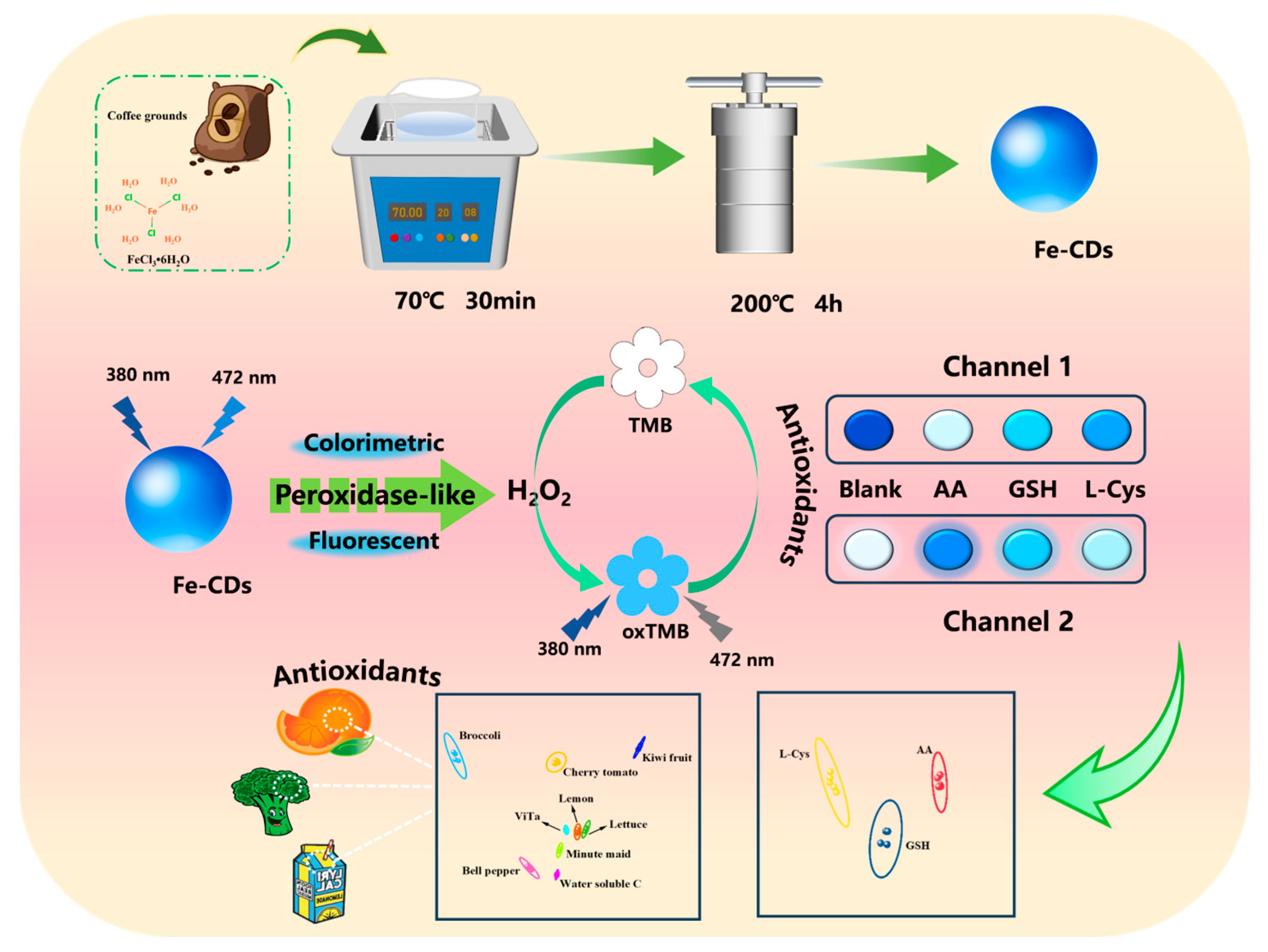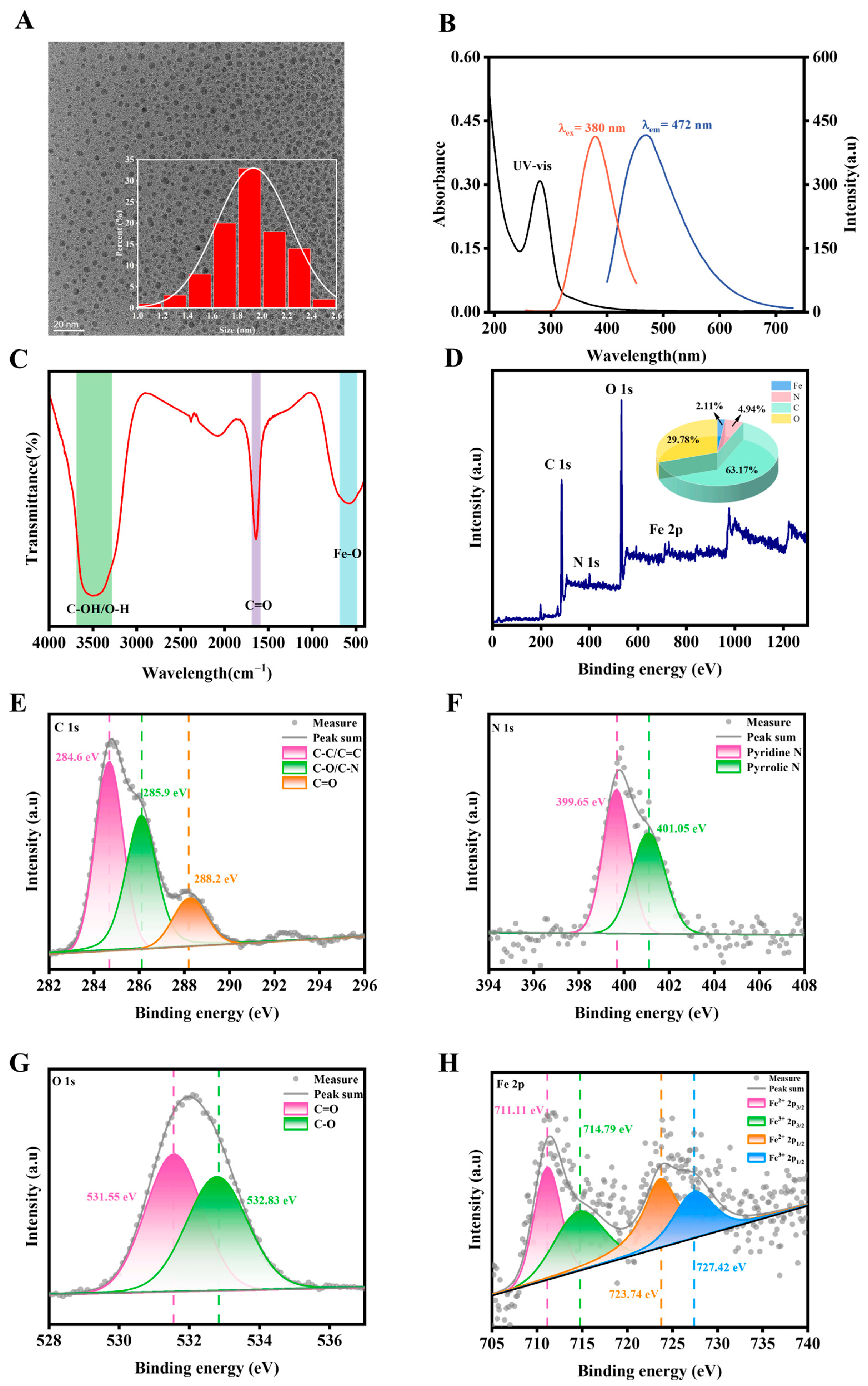Sustainable Conversion of Coffee Ground Waste into Carbon Dots for Sensing Food Antioxidants
Abstract
1. Introduction
2. Materials and Methods
2.1. Reagents and Instruments
2.2. Preparation of Fe-CDs
2.3. Quantum Yield of Fe-CDs
2.4. Peroxidase-like Activity and Kinetic Assay
- (i)
- TMB (10 mM) + H2O2 (0.4, 0.6, 0.8, 1.0, 1.5, 2.0, 3.0 mM) + Fe-CDs;
- (ii)
- H2O2 (50 mM) + TMB (0.4, 0.6, 0.8, 1.0, 1.5, 2.0, 3.0 mM) + Fe-CDs;
2.5. Accurate Detection of GSH, L-Cys, AA
2.6. Detection in Real Samples
3. Results
3.1. Characterization of Fe-CDs
3.2. Peroxidase-Mimicking Activity of Fe-CDs
3.3. Mechanism of Catalysis
3.4. Detection of Antioxidants Based on the Dual Channel Sensor Array
3.5. Identification of Actual Samples
4. Conclusions
Supplementary Materials
Author Contributions
Funding
Institutional Review Board Statement
Informed Consent Statement
Data Availability Statement
Conflicts of Interest
References
- Gharai, P.K.; Khan, J.; Mallesh, R.; Garg, S.; Saha, A.; Ghosh, S.; Ghosh, S. Vanillin benzothiazole derivative reduces cellular reactive oxygen species and detects amyloid fibrillar aggregates in alzheimer’s disease brain. ACS Chem. Neurosci. 2023, 14, 773–786. [Google Scholar] [CrossRef] [PubMed]
- Krishnendu, M.R.; Singh, S. Reactive oxygen species: Advanced detection methods and coordination with nanozymes. Chem. Eng. J. 2025, 511, 161296. [Google Scholar] [CrossRef]
- Zhang, L.; Li, W.; Cao, J.; Yang, Y.; Gao, H. Injectable reactive oxygen and nitrogen species-scavenging hydrogels for repairing traumatic brain injury. Mater. Today Bio 2025, 35, 102336. [Google Scholar] [CrossRef]
- Sheng, L.-T.; Jiang, Y.-W.; Feng, L.; Pan, A.; Koh, W.-P.; Lipsitz, L. Dietary total antioxidant capacity and late-life cognitive impairment: The Singapore chinese health study. J. Gerontol. A 2022, 77, 561–569. [Google Scholar] [CrossRef]
- Dan, J.; Su, Z.; Sun, B.; Wang, J.; Zhang, W. A polymetallic nanozyme with high peroxidase mimetic activity for rapid evaluation of total antioxidant capacity. Microchem. J. 2023, 185, 103802. [Google Scholar] [CrossRef]
- Dienes-Nagy, Á.; Vuichard, F.; Belcher, S.; Blackford, M.; Rösti, J.; Lorenzini, F. Simultaneous quantification of glutathione, glutathione disulfide and glutathione-s-sulfonate in grape and wine using lc-ms/ms. Food Chem. 2022, 386, 132756. [Google Scholar] [CrossRef]
- Yang, Y.; Wu, D.; He, J.; Zheng, Q.; Mo, Y.; Jin, C.; Gan, N.; Huang, S. Cu2O-decorated MoS2 nanoflowers with enhanced specific recognition for glutathione and its ultrasnsitive electrochemical detection. Microchem. J. 2025, 217, 114998. [Google Scholar] [CrossRef]
- Li, C.; Zeng, J.; Guo, D.; Liu, L.; Xiong, L.; Luo, X.; Hu, Z.; Wu, F. Cobalt-doped carbon quantum dots with peroxidase-mimetic activity for ascorbic acid detection through both fluorometric and colorimetric methods. ACS Appl. Mater. Interfaces 2021, 13, 49453–49461. [Google Scholar] [CrossRef]
- Yang, L.; Yang, Z.; He, J.; Cao, Q.; Zhang, R.; Wang, Q.; Chen, Z.; Chen, W.; Wang, W. Palladium/rhodium/iridium trimetallic octahedral nanozymes exhibiting enhanced peroxidase-like activity for detecting total antioxidant capacity in food. ACS Appl. Nano Mater. 2023, 6, 4288–4296. [Google Scholar] [CrossRef]
- Liu, X.; Wu, F.; Zheng, X.; Liu, H.; Ren, F.; Sun, J.; Ding, H.; Yang, R.; Jin, L. Facile synthesis of high-loading Cu single-atom nanozyme for total antioxidant capacity sensing. ACS Appl. Nano Mater. 2023, 6, 10303–10311. [Google Scholar] [CrossRef]
- He, Y.; Feng, M.; Zhang, X.; Huang, Y. Mof-derived bundle-like Mn doped NiO with rich oxygen vacancy as oxidase mimic for the determination of total antioxidant capacity. Sens. Actuators B Chem. 2025, 428, 137227. [Google Scholar] [CrossRef]
- Li, Z.; Askim, J.R.; Suslick, K.S. The optoelectronic nose: Colorimetric and fluorometric sensor arrays. Chem. Rev. 2018, 119, 231–292. [Google Scholar] [CrossRef]
- Sun, J.; Lu, Y.; He, L.; Pang, J.; Yang, F.; Liu, Y. Colorimetric sensor array based on gold nanoparticles: Design principles and recent advances. TrAC Trends Anal. Chem. 2020, 122, 115754. [Google Scholar] [CrossRef]
- Li, W.-T.; Wang, J.-S.; Pang, M.; Li, Y.; Ruan, W.-J. Fluorescent sensor array for tetracyclines discrimination using a single dye@mof composite sensor. Sens. Actuators B Chem. 2023, 381, 133375. [Google Scholar] [CrossRef]
- Liu, H.; Zhong, X.; Pan, Q.; Zhang, Y.; Deng, W.; Zou, G.; Hou, H.; Ji, X. A review of carbon dots in synthesis strategy. Coord. Chem. Rev. 2024, 498, 215468. [Google Scholar] [CrossRef]
- Cao, L.; Zan, M.; Chen, F.; Kou, X.; Liu, Y.; Wang, P.; Mei, Q.; Hou, Z.; Dong, W.-F.; Li, L. Formation mechanism of carbon dots: From chemical structures to fluorescent behaviors. Carbon 2022, 194, 42–51. [Google Scholar] [CrossRef]
- Sharma, S.; Kumar, R.; Kumar, K.; Thakur, N. Sustainable applications of biowaste-derived carbon dots in eco-friendly technological advancements: A review. Mater. Sci. Eng. B 2024, 305, 117414. [Google Scholar] [CrossRef]
- Kang, C.; Huang, Y.; Yang, H.; Yan, X.F.; Chen, Z.P. A review of carbon dots produced from biomass wastes. Nanomaterials 2020, 10, 2316. [Google Scholar] [CrossRef]
- Wang, Y.; Zhang, M.; Shen, X.; Wang, H.; Wang, H.; Xia, K.; Yin, Z.; Zhang, Y. Biomass-derived carbon materials: Controllable preparation and versatile applications. Small 2021, 17, 200879. [Google Scholar] [CrossRef] [PubMed]
- Wang, C.; Yang, J.; Gu, X.; Wang, H.; Wang, X.; Wang, Z.; Sun, G. Nitrogen-doped waste biomass-derived carbon dots as fluorescent sensors for economical, green, rapid and sensitive detection of resveratrol in foods. Food Chem. 2025, 472, 142886. [Google Scholar] [CrossRef] [PubMed]
- Ren, H.; Yuan, Y.; Labidi, A.; Dong, Q.; Zhang, K.; Lichtfouse, E.; Allam, A.A.; Ajarem, J.S.; Wang, C. Green process of biomass waste derived fluorescent carbon quantum dots for biological imaging in vitro and in vivo. Chin. Chem. Lett. 2023, 34, 107998. [Google Scholar] [CrossRef]
- Meng, W.; Wang, B.; Ai, L.; Song, H.; Lu, S. Engineering white light-emitting diodes with high color rendering index from biomass carbonized polymer dots. J. Colloid Interface Sci. 2021, 598, 274–282. [Google Scholar] [CrossRef]
- Moccand, C.; Manchala, A.D.; Sauvageat, J.-L.; Lima, A.; FleuryRey, Y.; Glabasnia, A. Improvement of robusta coffee aroma by modulating flavor precursors in the green coffee bean with enzymatically treated spent coffee grounds: A circular approach. Food Res. Int. 2023, 170, 112987. [Google Scholar] [CrossRef]
- Bondam, A.F.; Diolinda da Silveira, D.; Pozzada dos Santos, J.; Hoffmann, J.F. Phenolic compounds from coffee by-products: Extraction and application in the food and pharmaceutical industries. Trends Food Sci. Technol. 2022, 123, 172–186. [Google Scholar] [CrossRef]
- Choe, U. Valorization of spent coffee grounds and their applications in food science. Curr. Res. Food Sci. 2025, 10, 101010. [Google Scholar] [CrossRef] [PubMed]
- Remón, J.; Ravaglio-Pasquini, F.; Pedraza-Segura, L.; Arcelus-Arrillaga, P.; Suelves, I.; Pinilla, J.L. Caffeinating the biofuels market: Effect of the processing conditions during the production of biofuels and high-value chemicals by hydrothermal treatment of residual coffee pulp. J. Clean. Prod. 2021, 302, 127008. [Google Scholar] [CrossRef]
- Zhu, Y.; Deng, X.; Chen, J.; Hu, Z.; Wu, F. Coffee grounds-derived carbon quantum dots as peroxidase mimetics for colorimetric and fluorometric detection of ascorbic acid. Food Chem. 2023, 429, 136957. [Google Scholar] [CrossRef]
- Gao, G.; Xia, H.; Shi, J.; Zheng, P.; Wu, W.; Wu, S.; Qi, T.; Song, H.; Gu, Y.; Li, J.; et al. Carbon dot nanozymes with ferrous ion-chelating and antioxidative activity inhibiting ferroptosis to alleviate renal ischemia-reperfusion injury. Small 2025, 21, 2407372. [Google Scholar] [CrossRef]
- Kayani, K.F. Phosphorus-doped carbon dots and their analytical and bioanalytical applications: A review. Talanta 2026, 297, 128768. [Google Scholar] [CrossRef]
- Li, X.; Fu, Y.; Zhao, S.; Xiao, J.; Lan, M.; Wang, B.; Zhang, K.; Song, X.; Zeng, L. Metal ions-doped carbon dots: Synthesis, properties, and applications. Chem. Eng. J. 2022, 430, 133101. [Google Scholar] [CrossRef]
- Zhou, X.; Li, L.; Wang, Y.; Kong, T.; Cao, Z.; Xie, H.; Liang, W.; Wang, Y.; Qian, S.; Chao, J.; et al. Nanozyme inhibited sensor array for biothiol detection and disease discrimination based on metal ion-doped carbon dots. Anal. Chem. 2023, 95, 8906–8913. [Google Scholar] [CrossRef] [PubMed]
- Li, T.; Xia, J.; Wu, M.; Liu, C.; Sun, Y.; Zhao, W.; Qian, M.; Wang, W.; Duan, W.; Xu, S. Single-atom iridium-doped carbon dots nanozyme with high peroxidase-like activity as colorimetric sensors for multimodal detection of mercury ions. Small 2025, 21, 2408785. [Google Scholar] [CrossRef]
- Yang, X.; Xiao, Y.; Zhao, Y.; Han, H.; Zheng, H.; Zhang, X. Highly sensitive chemiluminescent sensor for detecting o-toluenesulfonamide and sulfamethoxazole using cu-doped carbon dots. Talanta 2024, 280, 126727. [Google Scholar] [CrossRef]
- Li, S.; Zhang, H.; Bao, Y.; Zhang, H.; Wang, J.; Liu, M.; Yan, R.; Wang, Z.; Wu, X.; Jin, Y. Immunoantitumor activity and oxygenation effect based on iron–copper-doped folic acid carbon dots. ACS Appl. Mater. Interfaces 2024, 16, 16653–16668. [Google Scholar] [CrossRef]
- Cai, B.; Ouyang, S.; Fan, J.; Liu, C.; Zhang, Y.; Wei, Z.; Wang, Z.; Wang, X.; Lei, H. Preparation of highly-efficient fe, n co-doping biochar from spent coffee grounds for the degradation of antibiotics via fenton-like reaction. J. Environ. Manag. 2025, 388, 126051. [Google Scholar] [CrossRef]
- Li, X.; Yang, X.; Wu, J.; Yang, Z.; Zhu, X. A novel four-channel sensor array with dual enzymes and dual modes for evaluating total antioxidant capacity in foods. ACS Sens. 2025, 10, 2883–2894. [Google Scholar] [CrossRef]
- Kang, J.-W.; Kim, J.-Y.; Kang, D.-H. Synthesis of carbon quantum dot synthesized using spent coffee ground as a biomass exhibiting visible-light-driven antimicrobial activity against foodborne pathogens. J. Food Eng. 2024, 365, 111820. [Google Scholar] [CrossRef]
- Li, D.; Lei, X.; Liu, Q.; Chen, Y.; Wang, J.; Han, B.; He, G. CuNCs assisted by carbon dots to construct z-type heterostructures: Ultra-high photocatalytic performance and peroxidase-like activity. Sep. Purif. Technol. 2023, 322, 124133. [Google Scholar] [CrossRef]
- Tummala, S.; Bandi, R.; Ho, Y.-P. Synthesis of Cu-doped carbon dot/chitosan film composite as a catalyst for the colorimetric detection of hydrogen peroxide and glucose. Microchim. Acta 2022, 189, 284. [Google Scholar] [CrossRef]
- Su, D.; Li, H.; Yan, X.; Lin, Y.; Lu, G. Biosensors based on fluorescence carbon nanomaterials for detection of pesticides. TrAC Trends Anal. Chem. 2021, 134, 116126. [Google Scholar] [CrossRef]






Disclaimer/Publisher’s Note: The statements, opinions and data contained in all publications are solely those of the individual author(s) and contributor(s) and not of MDPI and/or the editor(s). MDPI and/or the editor(s) disclaim responsibility for any injury to people or property resulting from any ideas, methods, instructions or products referred to in the content. |
© 2025 by the authors. Licensee MDPI, Basel, Switzerland. This article is an open access article distributed under the terms and conditions of the Creative Commons Attribution (CC BY) license (https://creativecommons.org/licenses/by/4.0/).
Share and Cite
Jiang, N.; Tao, Y.; Wang, R.; Zhao, X.; Ren, J.; Jiang, C.; Xu, Z.; Zhuang, X.; Shi, C. Sustainable Conversion of Coffee Ground Waste into Carbon Dots for Sensing Food Antioxidants. Foods 2025, 14, 3922. https://doi.org/10.3390/foods14223922
Jiang N, Tao Y, Wang R, Zhao X, Ren J, Jiang C, Xu Z, Zhuang X, Shi C. Sustainable Conversion of Coffee Ground Waste into Carbon Dots for Sensing Food Antioxidants. Foods. 2025; 14(22):3922. https://doi.org/10.3390/foods14223922
Chicago/Turabian StyleJiang, Nan, Yuanjing Tao, Ruihong Wang, Xiaoran Zhao, Jingxuan Ren, Chenyang Jiang, Zihao Xu, Xuming Zhuang, and Chao Shi. 2025. "Sustainable Conversion of Coffee Ground Waste into Carbon Dots for Sensing Food Antioxidants" Foods 14, no. 22: 3922. https://doi.org/10.3390/foods14223922
APA StyleJiang, N., Tao, Y., Wang, R., Zhao, X., Ren, J., Jiang, C., Xu, Z., Zhuang, X., & Shi, C. (2025). Sustainable Conversion of Coffee Ground Waste into Carbon Dots for Sensing Food Antioxidants. Foods, 14(22), 3922. https://doi.org/10.3390/foods14223922





